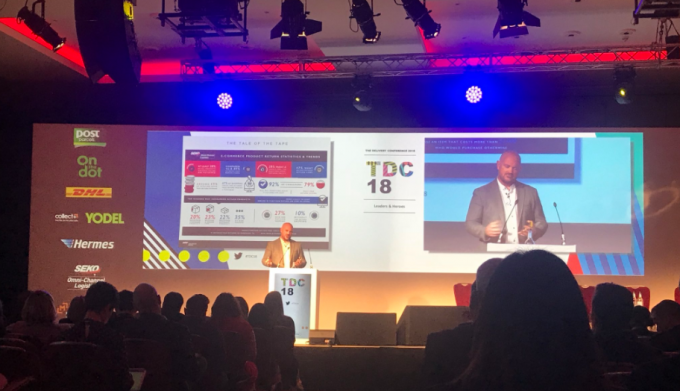As 'gift' season looms, airlines must know exactly what cargo they are carrying
It’s not just the loss of taxes or the import of illegal substances that is ...
GM: RAISING THE ROOF GGM: IN FULL THROTTLE GZIM: MAERSK BOOST KNIN: READ-ACROSSMAERSK: NOT ENOUGHMAERSK: GUIDANCE UPGRADEZIM: ROLLERCOASTERCAT: HEAVY DUTYMAERSK: CATCHING UP PG: DESTOCKING PATTERNSPG: HEALTH CHECKWTC: THE FALLGXO: DEFENSIVE FWRD: RALLYING ON TAKEOVER TALKODFL: STEADY YIELDVW: NEW MODEL NEEDEDWTC: TAKING PROFIT
GM: RAISING THE ROOF GGM: IN FULL THROTTLE GZIM: MAERSK BOOST KNIN: READ-ACROSSMAERSK: NOT ENOUGHMAERSK: GUIDANCE UPGRADEZIM: ROLLERCOASTERCAT: HEAVY DUTYMAERSK: CATCHING UP PG: DESTOCKING PATTERNSPG: HEALTH CHECKWTC: THE FALLGXO: DEFENSIVE FWRD: RALLYING ON TAKEOVER TALKODFL: STEADY YIELDVW: NEW MODEL NEEDEDWTC: TAKING PROFIT

European retailers should expand their e-commerce offering to Asia Pacific, which is cheaper and easier than many believe, retailers heard yesterday.
“Asia Pacific has very little focus for UK e-commerce,” said Justin Irvine, commercial director of SEKO Omni-Channel Logistics.
“The US is a mature market and Asia is starting to see shifts in buying behaviour.”
Speaking at The Delivery Conference in London, Mr Irvine added: “There is a misconception that Asia Pacific is a horrible delivery experience. That has changed in the past 18 months, and you can get in for the same price as in Europe.
“Asia Pacific is an easy market to access,” he added. “It’s the largest growth market and has the least focus for UK brands.
“Expectations bring challenges, every region being a little different, especially when they are on the other side of the world. However, this is not as scary or daunting as you think, nor as costly. You can deliver to Asia and Australasia in two to three days for less than £10.”
Australia in particular has a very high de minimis threshold to liability to customs duty and tax of A$1,000 ($811), a rate which acts as a high accelerator of cross-border e-commerce.
The market in Asia Pacific is also huge. By 2021, the continent will account for 40% of the total $213bn spend, according to McKinsey. Western Europe will take a 17% share and North America will account for 34%.
Ludwig Hausmann, partner at McKinsey & Co, added that one in every five dollars spent on e-commerce would be on cross-border purchases by 2025.
“Are the shipping operations sufficient? Integrators are very costly. We have seen a lot of start-ups experimenting, with new partnerships with cargo carriers and the last mile. There are huge opportunities, but it is extremely hard to chart a strategic course up to 2025. But the sky is the limit in e-commerce logistics.”
UK brands are now trading the world over, as delivery options – the cornerstone of e-commerce – improve.
Sir Ian Cheshire, chairman of Debenhams, noted that the shop now sold in 40 countries where it has no physical presence.
“E-commerce is different in different countries. The UK leads; there is a wide variety, but everyone is approaching scale. There are platforms around the world now.
“Boden is now a global business. We are still at an early stage of going global. There wasn’t a global delivery partner and that has changed radically. You can now get a seamless delivery experience and that’s where you’ll get a lot of incremental growth.”
Online Latin American retail group Dafiti, meanwhile warned that the region was tough.
“In Brazil, there are 100m people on the internet, but the e-commerce market is small and fragmented,” said Thibaud Lecuyer, CCO and co-founder.
“There is enormous potential. Dafiti accounts for barely 3% of a $80-$100bn market. We had three years of recession and last year was flat. E-commerce has slowed down, but is now picking up.”
Delivery is one of the biggest challenges, he added. “You don’t have DHL or FedEx [at the same level[. The best is a private carrier, that can do about two to four states – out of 27. And you rapidly reach the capacity of those people. So you have to find smaller transportation companies.”
Dr Hausmann added that 78% of respondents to a McKinsey survey thought that low-value cross-border e-commerce would grow, and 73% thought high-value cross-border would grow.
The reasons for cross-border purchases are simple, he said: “Product availability, price, greater selection, product quality.”
Comment on this article
Vivian Simmons
February 04, 2018 at 11:09 amHaving read so much about e-commerce being the future blah blah blah…I am wondering, will e-commerce actually pick up due to propaganda or is it actually something of the future?
Personally I do not see people going frenzy about on-line shopping. There were and will be many first time buyers, like me, but it has frizzled off.
So what is all this gossip still going on about?
With buyers demanding Free delivery and fuel costs going up…where is the true link to make a successful e-commerce future?
Purely my inquisitiveness